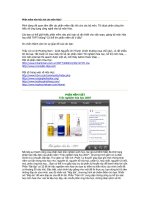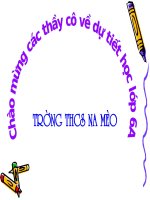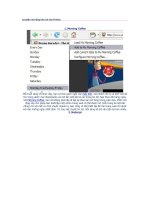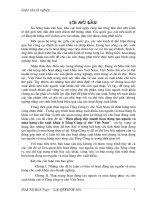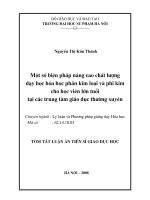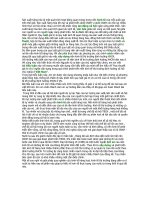MSQs biochemistry Môn Hóa Sinh ĐHCT. Biên soạn TS. Đáy Thị Xuân . Đây là một giáo trình hay và hữu ích cho sinh viên hóa sinh.
Bạn đang xem bản rút gọn của tài liệu. Xem và tải ngay bản đầy đủ của tài liệu tại đây (2.31 MB, 301 trang )
This page
intentionally left
blankCopyright © 2008, New Age International (P) Ltd., Publishers
Published by New Age International (P) Ltd., Publishers
All rights reserved.
No part of this ebook may be reproduced in any form, by photostat, microfilm,
xerography, or any other means, or incorporated into any information retrieval
system, electronic or mechanical, without the written permission of the publisher.
All inquiries should be emailed to
PUBLISHING FOR ONE WORLD
NEW AGE INTERNATIONAL (P) LIMITED, PUBLISHERS
4835/24, Ansari Road, Daryaganj, New Delhi - 110002
Visit us at www.newagepublishers.com
ISBN (13) : 978-81-224-2627-4
Dedicated to
PROF. DR. F.V. MANVI
SecretarySecretary
SecretarySecretary
Secretary
KLE Society, BELGAUM
KARNATAKA.
“To My First Pharmacy teacher with Love”
This page
intentionally left
blank
FOREWORDFOREWORD
FOREWORDFOREWORD
FOREWORD
Competitive Examinations are the order of the day. All Colleges conducting professional courses at PG level are
admitting students based on common entrance examination, which is of objective type.
In Pharmacy, M.Pharm admissions are based on qualifying the GATE enterance examination conducted by Govt.
of India.
In this book, The author has done good work in preparing several objective questions which help the students to face
the subject in the examination with poise and confidence.
The book is well balanced and consists of multiple choice questions from all the important topics like carbohydrate
metabolism and other important Biochemical aspects.
The typesetting and quality of printing is good. The author is also well experienced in taking up this type of work.
I recommend this book to all the students preparing for GATE examination and also for Medical and Pharmacy
College libraries.
PROF. B.G. SHIVANANDA
Principal
AL-AMEEN COLLEGE OF PHARMACY
BANGALORE.
WATER AND ELECTROLYTE BALANCE
289
PREFPREF
PREFPREF
PREF
AA
AA
A
CECE
CECE
CE
I have brought out this book basically for students who plan to appear for Biochemistry in the entrance examinations like
JIPMER and other Medical, Pharmacy, Physiotherapy, Nursing and other Paramedical PG Entrance Examinations. There
is a dearth of good entrance manual of Biochemistry for the above said examinations. Hence, I have prepared an
exhaustive Question bank of around 5000 MCQs with answers covering a wide spectrum of basic Biochemical topics of
the subject.
Some of the important topics which are given a good coverage include Carbohydrate metabolism, Protein metabo-
lism, Lipid metabolism, Nucleic acids, Enzymes, Vitamins and Mineral metabolism.
The objective questions are prepared based on the background taken from previous question papers of Profes-
sional medical and Paramedical competitive entrance examinations.
The book serves as a ready reckoner for Biochemistry as far as objective pattern is concerned. I feel satisfied if the
book serves the purpose for which it is intended.
I have tried to minimize typographical errors but still some must have crept in. If they are brought to my notice, I will
be rectifying them in the next edition.
Constructive Criticism is always welcome
G. Vidya Sagar
AA
AA
A
CKNOWLEDGEMENTSCKNOWLEDGEMENTS
CKNOWLEDGEMENTSCKNOWLEDGEMENTS
CKNOWLEDGEMENTS
I wish to express my profound gratitude and benevolence to the following who were the inspiring force in making this
book a reality
• Sadhvi Shilapiji
Chair person, Veerayatan Vidyapeeth,
Jakhaniya, Kutch, Gujarat
• Prof. Dr. R.K. Goyal
L.M. College of Pharmacy
Ahmedabad, Gujarat
• Prof. Dr. A.K. Saluja
A.R. College of Pharmacy
Vallabh Vidyanagar
Gujarat
• Prof. J.V.L.N. Sheshagiri Rao
Dept. of Pharmaceutical Sciences
Andhra University, Vishakhapatnam, A.P.
Finally, I express my gratitude to Mr. Saumya Gupta. MD, New Age International (P) Limited, New Delhi, for his
encouragement and support.
Dr. G.Vidya Sagar
• Prof. Dr. Kishor Pramod Bhusari
Principal, Nagpur College of Pharmacy
Nagpur.
• Prof. Dr. R. Rangari
Principal, J.N. Chaturvedi College of Pharmacy
Nagpur
• Prof. Dr. Anant Naik Nagappa
Pharmacy group, Birla Institute of Technology &
Sciences
Pilani, Rajasthan
• Prof. Dr. Srinivas Rao
Principal, VEL’s College of Pharmacy
Chennai
SOME VSOME V
SOME VSOME V
SOME V
ALUALU
ALUALU
ALU
ABLE COMMENTSABLE COMMENTS
ABLE COMMENTSABLE COMMENTS
ABLE COMMENTS
This book is very useful for students appearing for GATE Exams. Recommended reading.
Prof. Dr. Subhas C. Marihal
Principal, Goa College of Pharmacy, Goa.
Biochemistry made simple in the form of multiple choice questions. Strongly recommended.
Prof. Dr. Vijaykumar Ishwar Hukkeri
Principal, KLE College of Pharmacy, Hubli
Dr. Vidya Sagar can be applauded for his untiring efforts in bringing out such a good book.
Recommended for students and Library
Dr. G. Devala Rao
Principal, Sidhartha College of Pharmaceutical Sciences
Vijaywada, A.P.
This book will be very useful companion for students appearing for PG Medical, Pharmacy, Nursing and
Physiotherapy competitive exams.
Prof. Dr. T.K. Ravi
Principal, Sri Ramakrishna Institute of Pharmaceutical Science
Coimbatore.
MCQs are well framed, mostly from previous entrance examinations. Commendable work.
Prof. Madhukar R. Tajne
Deptt. of Pharmaceutical Sciences,
Nagpur University, Nagpur
CC
CC
C
ONTENTSONTENTS
ONTENTSONTENTS
ONTENTS
Preface (x)
Chapter 1
INTRODUCTION TINTRODUCTION T
INTRODUCTION TINTRODUCTION T
INTRODUCTION T
O BIOCHEMISTRYO BIOCHEMISTRY
O BIOCHEMISTRYO BIOCHEMISTRY
O BIOCHEMISTRY
11
11
1
CHAPTER 2
CARBOHYDRACARBOHYDRA
CARBOHYDRACARBOHYDRA
CARBOHYDRA
TES AND CARBOHYDRATES AND CARBOHYDRA
TES AND CARBOHYDRATES AND CARBOHYDRA
TES AND CARBOHYDRA
TE METTE MET
TE METTE MET
TE MET
ABOLISMABOLISM
ABOLISMABOLISM
ABOLISM
55
55
5
CHAPTER 3
PROPRO
PROPRO
PRO
TEINS & PROTEINS & PRO
TEINS & PROTEINS & PRO
TEINS & PRO
TEIN METTEIN MET
TEIN METTEIN MET
TEIN MET
ABOLISMABOLISM
ABOLISMABOLISM
ABOLISM
2727
2727
27
CHAPTER 4
FF
FF
F
AA
AA
A
TS & FTS & F
TS & FTS & F
TS & F
AA
AA
A
TTY ATTY A
TTY ATTY A
TTY A
CID METCID MET
CID METCID MET
CID MET
ABOLISMABOLISM
ABOLISMABOLISM
ABOLISM
7575
7575
75
CHAPTER 5
VITVIT
VITVIT
VIT
AMINSAMINS
AMINSAMINS
AMINS
113113
113113
113
CHAPTER 6
ENZYMESENZYMES
ENZYMESENZYMES
ENZYMES
141141
141141
141
CHAPTER 7
MINERAL METMINERAL MET
MINERAL METMINERAL MET
MINERAL MET
ABOLISMABOLISM
ABOLISMABOLISM
ABOLISM
183183
183183
183
CHAPTER 8
HORMONE METHORMONE MET
HORMONE METHORMONE MET
HORMONE MET
ABOLISMABOLISM
ABOLISMABOLISM
ABOLISM
209209
209209
209
CHAPTER 9
NUCLEIC ANUCLEIC A
NUCLEIC ANUCLEIC A
NUCLEIC A
CIDSCIDS
CIDSCIDS
CIDS
237237
237237
237
CHAPTER 10
WW
WW
W
AA
AA
A
TER & ELECTROLTER & ELECTROL
TER & ELECTROLTER & ELECTROL
TER & ELECTROL
YTE BALANCEYTE BALANCE
YTE BALANCEYTE BALANCE
YTE BALANCE
281281
281281
281
This page
intentionally left
blank
CHAPTER CHAPTER
CHAPTER CHAPTER
CHAPTER
11
11
1
I I
I I
I
NTRODUCTIONNTRODUCTION
NTRODUCTIONNTRODUCTION
NTRODUCTION
TOTO
TOTO
TO
BB
BB
B
IOCHEMISTRYIOCHEMISTRY
IOCHEMISTRYIOCHEMISTRY
IOCHEMISTRY
1. A drug which prevents uric acid synthesis
by inhibiting the enzyme xanthine
oxidase is
(A) Aspirin (B) Allopurinol
(C) Colchicine (D) Probenecid
2. Which of the following is required for
crystallization and storage of the
hormone insulin?
(A) Mn
++
(B) Mg
++
(C) Ca
++
(D) Zn
++
3. Oxidation of which substance in the body
yields the most calories
(A) Glucose (B) Glycogen
(C) Protein (D) Lipids
4. Milk is deficient in which vitamins?
(A) Vitamin C (B) Vitamin A
(C) Vitamin B
2
(D) Vitamin K
5. Milk is deficient of which mineral?
(A) Phosphorus (B) Sodium
(C) Iron (D) Potassium
6. Synthesis of prostaglandinsis is inhibited
by
(A) Aspirin (B) Arsenic
(C) Fluoride (D) Cyanide
7. HDL is synthesized and secreted from
(A) Pancreas (B) Liver
(C) Kidney (D) Muscle
8. Which are the cholesterol esters that enter
cells through the receptor-mediated
endocytosis of lipoproteins hydrolyzed?
(A) Endoplasmin reticulum
(B) Lysosomes
(C) Plasma membrane receptor
(D) Mitochondria
9. Which of the following phospholipids is
localized to a greater extent in the outer
leaflet of the membrane lipid bilayer?
(A) Choline phosphoglycerides
(B) Ethanolamine phosphoglycerides
(C) Inositol phosphoglycerides
(D) Serine phosphoglycerides
10. All the following processes occur rapidly
in the membrane lipid bilayer except
(A) Flexing of fatty acyl chains
(B) Lateral diffusion of phospholipids
(C) Transbilayer diffusion of phopholipids
(D) Rotation of phospholipids around their long
axes
11. Which of the following statement is
correct about membrane cholesterol?
(A) The hydroxyl group is located near the centre
of the lipid layer
(B) Most of the cholesterol is in the form of a
cholesterol ester
(C) The steroid nucleus form forms a rigid, planar
structure
MCQs IN BIOCHEMISTRY
2
(D) The hydrocarbon chain of cholesterol projects
into the extracellular fluid
12. Which one is the heaviest particulate
component of the cell?
(A) Nucleus (B) Mitochondria
(C) Cytoplasm (D) Golgi apparatus
13. Which one is the largest particulate of the
cytoplasm?
(A) Lysosomes
(B) Mitochondria
(C) Golgi apparatus
(D) Entoplasmic reticulum
14. The degradative Processess are categorized
under the heading of
(A) Anabolism (B) Catabolism
(C) Metabolism (D) None of the above
15. The exchange of material takes place
(A) Only by diffusion
(B) Only by active transport
(C) Only by pinocytosis
(D) All of these
16. The average pH of Urine is
(A) 7.0 (B) 6.0
(C) 8.0 (D) 0.0
17. The pH of blood is 7.4 when the ratio
between H
2
CO
3
and NaHCO
3
is
(A) 1 : 10 (B) 1 : 20
(C) 1 : 25 (C) 1 : 30
18. The phenomenon of osmosis is opposite
to that of
(A) Diffusion (B) Effusion
(C) Affusion (D) Coagulation
19. The surface tension in intestinal lumen
between fat droplets and aqueous
medium is decreased by
(A) Bile Salts (B) Bile acids
(C) Conc. H
2
SO
4
(D) Acetic acid
20. Which of the following is located in the
mitochondria?
(A) Cytochrome oxidase
(B) Succinate dehydrogenase
(C) Dihydrolipoyl dehydrogenase
(C) All of these
21. The most active site of protein synthesis
is the
(A) Nucleus (B) Ribosome
(C) Mitochondrion (D) Cell sap
22. The fatty acids can be transported into
and out of mitochondria through
(A) Active transport
(B) Facilitated transfer
(C) Non-facilitated transfer
(D) None of these
23. Mitochondrial DNA is
(A) Circular double stranded
(B) Circular single stranded
(C) Linear double helix
(D) None of these
24. The absorption of intact protein from the
gut in the foetal and newborn animals
takes place by
(A) Pinocytosis (B) Passive diffusion
(C) Simple diffusion (D) Active transport
25. The cellular organelles called “suicide
bags” are
(A) Lysosomes (B) Ribosomes
(C) Nucleolus (D) Golgi’s bodies
26. From the biological viewpoint, solutions
can be grouped into
(A) Isotonic solution
(B) Hypotonic solutions
(C) Hypertonic solution
(D) All of these
27. Bulk transport across cell membrane is
accomplished by
(A) Phagocytosis (B) Pinocytosis
(C) Extrusion (D) All of these
28. The ability of the cell membrane to act as
a selective barrier depends upon
(A) The lipid composition of the membrane
(B) The pores which allows small molecules
(C) The special mediated transport systems
(D) All of these
INTRODUCTION TO BIOCHEMISTRY
3
29. Carrier protein can
(A) Transport only one substance
(B) Transport more than one substance
(C) Exchange one substance to another
(D) Perform all of these functions
30. A lipid bilayer is permeable to
(A) Urea (B) Fructose
(C) Glucose (D) Potassium
31. The Golgi complex
(A) Synthesizes proteins
(B) Produces ATP
(C) Provides a pathway for transporting chemicals
(D) Forms glycoproteins
32. The following points about microfilaments
are true except
(A) They form cytoskeleton with microtubules
(B) They provide support and shape
(C) They form intracellular conducting channels
(D) They are involved in muscle cell contraction
33. The following substances are cell
inclusions except
(A) Melanin (B) Glycogen
(C) Lipids (D) Centrosome
34. Fatty acids can be transported into and
out of cell membrane by
(A) Active transport (B) Facilitated transport
(C) Diffusion (D) Osmosis
35. Enzymes catalyzing electron transport
are present mainly in the
(A) Ribosomes
(B) Endoplasmic reticulum
(C) Lysosomes
(D) Inner mitochondrial membrane
36. Mature erythrocytes do not contain
(A) Glycolytic enzymes(B) HMP shunt enzymes
(C) Pyridine nucleotide(D) ATP
37. In mammalian cells rRNA is produced
mainly in the
(A) Endoplasmic reticulum
(B) Ribosome
(C) Nucleolus
(D) Nucleus
38. Genetic information of nuclear DNA is
transmitted to the site of protein synthesis
by
(A) rRNA (B) mRNA
(C) tRNA (D) Polysomes
39. The power house of the cell is
(A) Nucleus (B) Cell membrane
(C) Mitochondria (D) Lysosomes
40. The digestive enzymes of cellular
compounds are confined to
(A) Lysosomes (B) Ribosomes
(C) Peroxisomes (D) Polysomes
ANSWERS
1. B 2. D 3. D 4. A 5. C 6. A
7. B 8. B 9. A 10. C 11. C 12. A
13. B 14. B 15. D 16. B 17. B 18. A
19. A 20. D 21. B 22. B 23. A 24. A
25. A 26. D 27. D 28. D 29. D 30. A
31. D 32. C 33. D 34. B 35. D 36. C
37. C 38. D 39. C 40. A
This page
intentionally left
blank
1. The general formula of monosaccharides
is
(A) C
n
H
2n
O
n
(B) C
2n
H
2
O
n
(C) C
n
H
2
O
2n
(D) C
n
H
2n
O
2n
2. The general formula of polysaccharides
is
(A) (C
6
H
10
O
5
)
n
(B) (C
6
H
12
O
5
)
n
(C) (C
6
H
10
O
6
)
n
(D) (C
6
H
10
O
6
)
n
3. The aldose sugar is
(A) Glycerose (B) Ribulose
(C) Erythrulose (D) Dihydoxyacetone
4. A triose sugar is
(A) Glycerose (B) Ribose
(C) Erythrose (D) Fructose
5. A pentose sugar is
(A) Dihydroxyacetone (B) Ribulose
(C) Erythrose (D) Glucose
6. The pentose sugar present mainly in the
heart muscle is
(A) Lyxose (B) Ribose
(C) Arabinose (D) Xylose
7. Polysaccharides are
(A) Polymers (B) Acids
(C) Proteins (D) Oils
8. The number of isomers of glucose is
(A) 2 (B) 4
(C) 8 (D) 16
CHAPTER 2CHAPTER 2
CHAPTER 2CHAPTER 2
CHAPTER 2
CC
CC
C
ARBOHYDRAARBOHYDRA
ARBOHYDRAARBOHYDRA
ARBOHYDRA
TESTES
TESTES
TES
ANDAND
ANDAND
AND
CC
CC
C
ARBOHYDRAARBOHYDRA
ARBOHYDRAARBOHYDRA
ARBOHYDRA
TETE
TETE
TE
MM
MM
M
ETET
ETET
ET
ABOLISMABOLISM
ABOLISMABOLISM
ABOLISM
9. Two sugars which differ from one another
only in configuration around a single
carbon atom are termed
(A) Epimers (B) Anomers
(C) Optical isomers (D) Stereoisomers
10. Isomers differing as a result of variations
in configuration of the —OH and —H on
carbon atoms 2, 3 and 4 of glucose are
known as
(A) Epimers (B) Anomers
(C) Optical isomers (D) Steroisomers
11. The most important epimer of glucose is
(A) Galactose (B) Fructose
(C) Arabinose (D) Xylose
12.
αα
αα
α-D-glucose and
β
-D-glucose are
(A) Stereoisomers (B) Epimers
(C) Anomers (D) Keto-aldo pairs
13.
αα
αα
α-D-glucose + 112
0
→
+ 52.5
0
←
+ 19
0
ββ
ββ
β-
D-glucose for glucose above represents
(A) Optical isomerism (B) Mutarotation
(C) Epimerisation (D) D and L isomerism
14. Compounds having the same structural
formula but differing in spatial
configuration are known as
(A) Stereoisomers (B) Anomers
(C) Optical isomers (D) Epimers
MCQs IN BIOCHEMISTRY
6
15. In glucose the orientation of the —H and
—OH groups around the carbon atom 5
adjacent to the terminal primary alcohol
carbon determines
(A) D or L series
(B) Dextro or levorotatory
(C) α and β anomers
(D) Epimers
16. The carbohydrate of the blood group
substances is
(A) Sucrose (B) Fucose
(C) Arabinose (D) Maltose
17. Erythromycin contains
(A) Dimethyl amino sugar
(B) Trimethyl amino sugar
(C) Sterol and sugar
(D) Glycerol and sugar
18. A sugar alcohol is
(A) Mannitol (B) Trehalose
(C) Xylulose (D) Arabinose
19. The major sugar of insect hemolymph is
(A) Glycogen (B) Pectin
(C) Trehalose (D) Sucrose
20. The sugar found in DNA is
(A) Xylose (B) Ribose
(C) Deoxyribose (D) Ribulose
21. The sugar found in RNA is
(A) Ribose (B) Deoxyribose
(C) Ribulose (D) Erythrose
22. The sugar found in milk is
(A) Galactose (B) Glucose
(C) Fructose (D) Lactose
23. Invert sugar is
(A) Lactose (B) Sucrose
(C) Hydrolytic products of sucrose
(D) Fructose
24. Sucrose consists of
(A) Glucose + glucose
(B) Glucose + fructose
(C) Glucose + galactose
(D) Glucose + mannose
25. The monosaccharide units are linked by
1
→→
→→
→ 4 glycosidic linkage in
(A) Maltose (B) Sucrose
(C) Cellulose (D) Cellobiose
26. Which of the following is a non-reducing
sugar?
(A) Isomaltose (B) Maltose
(C) Lactose (D) Trehalose
27. Which of the following is a reducing
sugar?
(A) Sucrose (B) Trehalose
(C) Isomaltose (D) Agar
28. A dissaccharide formed by 1,1-glycosidic
linkage between their monosaccharide
units is
(A) Lactose (B) Maltose
(C) Trehalose (D) Sucrose
29. A dissaccharide formed by 1,1-glycosidic
linkage between their monosaccharide
units is
(A) Lactose (B) Maltose
(C) Trehalose (D) Sucrose
30. Mutarotation refers to change in
(A) pH (B) Optical rotation
(C) Conductance (D) Chemical properties
31. A polysacchharide which is often called
animal starch is
(A) Glycogen (B) Starch
(C) Inulin (D) Dextrin
32. The homopolysaccharide used for
intravenous infusion as plasma substitute
is
(A) Agar (B) Inulin
(C) Pectin (D) Starch
33. The polysaccharide used in assessing the
glomerular fittration rate (GFR) is
(A) Glycogen (B) Agar
(C) Inulin (D) Hyaluronic acid
CARBOHYDRATES AND CARBOHYDRATE METABOLISM
7
34. The constituent unit of inulin is
(A) Glucose (B) Fructose
(C) Mannose (D) Galactose
35. The polysaccharide found in the
exoskeleton of invertebrates is
(A) Pectin (B) Chitin
(C) Cellulose (D) Chondroitin sulphate
36. Which of the following is a heteroglycan?
(A) Dextrins (B) Agar
(C) Inulin (D) Chitin
37. The glycosaminoglycan which does not
contain uronic acid is
(A) Dermatan sulphate
(B) Chondroitin sulphate
(C) Keratan sulphate
(D) Heparan sulphate
38. The glycosaminoglycan which does not
contain uronic acid is
(A) Hyaluronic acid
(B) Heparin
(C) Chondroitin sulphate
(D) Dermatan sulphate
39. Keratan sulphate is found in abundance
in
(A) Heart muscle (B) Liver
(C) Adrenal cortex (D) Cornea
40. Repeating units of hyaluronic acid are
(A) N-acetyl glucosamine and D-glucuronic acid
(B) N-acetyl galactosamine and D-glucuronic
acid
(C) N-acetyl glucosamine and galactose
(D) N-acetyl galactosamine and L- iduronic acid
41. The approximate number of branches in
amylopectin is
(A) 10 (B) 20
(C) 40 (D) 80
42. In amylopectin the intervals of glucose
units of each branch is
(A) 10–20 (B) 24–30
(C) 30–40 (D) 40–50
43. A polymer of glucose synthesized by the
action of leuconostoc mesenteroids in a
sucrose medium is
(A) Dextrans (B) Dextrin
(C) Limit dextrin (D) Inulin
44. Glucose on reduction with sodium
amalgam forms
(A) Dulcitol (B) Sorbitol
(C) Mannitol (D) Mannitol and sorbitol
45. Glucose on oxidation does not give
(A) Glycoside (B) Glucosaccharic acid
(C) Gluconic acid (D) Glucuronic acid
46. Oxidation of galactose with conc HNO
3
yields
(A) Mucic acid (B) Glucuronic acid
(C) Saccharic acid (D) Gluconic acid
47. A positive Benedict’s test is not given by
(A) Sucrose (B) Lactose
(C) Maltose (D) Glucose
48. Starch is a
(A) Polysaccharide (B) Monosaccharide
(C) Disaccharide (D) None of these
49. A positive Seliwanoff’s test is obtained
with
(A) Glucose (B) Fructose
(C) Lactose (D) Maltose
50. Osazones are not formed with the
(A) Glucose (B) Fructose
(C) Sucrose (D) Lactose
51. The most abundant carbohydrate found
in nature is
(A) Starch (B) Glycogen
(C) Cellulose (D) Chitin
52. Impaired renal function is indicated when
the amount of PSP excreted in the first 15
minutes is
(A) 20% (B) 35%
(C) 40% (D) 45%
53. An early feature of renal disease is
(A) Impairment of the capacity of the tubule to
perform osmotic work
MCQs IN BIOCHEMISTRY
8
(B) Decrease in maximal tubular excretory
capacity
(C) Decrease in filtration factor
(D) Decrease in renal plasma flow
54. ADH test is based on the measurement of
(A) Specific gravity of urine
(B) Concentration of urea in urine
(C) Concentration of urea in blood
(D) Volume of urine in ml/minute
55. The specific gravity of urine normally
ranges from
(A) 0.900–0.999 (B) 1.003–1.030
(C) 1.000–1.001 (D) 1.101–1.120
56. Specific gravity of urine increases in
(A) Diabetes mellitus
(B) Chronic glomerulonephritis
(C) Compulsive polydypsia
(D) Hypercalcemia
57. Fixation of specific gravity of urine to
1.010 is found in
(A) Diabetes insipidus
(B) Compulsive polydypsia
(C) Cystinosis
(D) Chronic glomerulonephritis
58. Addis test is the measure of
(A) Impairment of the capacity of the tubule to
perform osmotic work
(B) Secretory function of liver
(C) Excretory function of liver
(D) Activity of parenchymal cells of liver
59. Number of stereoisomers of glucose is
(A) 4 (B) 8
(C) 16 (D) None of these
60. Maltose can be formed by hydrolysis of
(A) Starch (B) Dextrin
(C) Glycogen (D) All of these
61.
α
–D–Glucuronic acid is present in
(A) Hyaluronic acid (B) Chondroitin sulphate
(C) Heparin (D) All of these
62. Fructose is present in hydrolysate of
(A) Sucrose (B) Inulin
(C) Both of the above (D) None of these
63. A carbohydrate found in DNA is
(A) Ribose (B) Deoxyribose
(C) Ribulose (D) All of these
64. Ribulose is a these
(A) Ketotetrose (B) Aldotetrose
(C) Ketopentose (D) Aldopentose
65. A carbohydrate, commonly known as
dextrose is
(A) Dextrin (B) D-Fructose
(C) D-Glucose (D) Glycogen
66. A carbohydrate found only in milk is
(A) Glucose (B) Galactose
(C) Lactose (D) Maltose
67. A carbohydrate, known commonly as
invert sugar, is
(A) Fructose (B) Sucrose
(C) Glucose (D) Lactose
68. A heteropolysacchraide among the
following is
(A) Inulin (B) Cellulose
(C) Heparin (D) Dextrin
69. The predominant form of glucose in
solution is
(A) Acyclic form
(B) Hydrated acyclic form
(C) Glucofuranose
(D) Glucopyranose
70. An L-isomer of monosaccharide formed in
human body is
(A) L-fructose (B) L-Erythrose
(C) L-Xylose (D) L-Xylulose
71. Hyaluronic acid is found in
(A) Joints (B) Brain
(C) Abdomen (D) Mouth
72. The carbon atom which becomes
asymmetric when the straight chain form
of monosaccharide changes into ring
form is known as
CARBOHYDRATES AND CARBOHYDRATE METABOLISM
9
(A) Anomeric carbon atom
(B) Epimeric carbon atom
(C) Isomeric carbon atom
(D) None of these
73. The smallest monosaccharide having
furanose ring structure is
(A) Erythrose (B) Ribose
(C) Glucose (D) Fructose
74. Which of the following is an epimeric pair?
(A) Glucose and fructose
(B) Glucose and galactose
(C) Galactose and mannose
(D) Lactose and maltose
75.
αα
αα
α-Glycosidic bond is present in
(A) Lactose (B) Maltose
(C) Sucrose (D) All of these
76. Branching occurs in glycogen approxi-
mately after every
(A) Five glucose units
(B) Ten glucose units
(C) Fifteen glucose units
(D) Twenty glucose units
77. N–Acetylglucosamnine is present in
(A) Hyaluronic acid (B) Chondroitin sulphate
(C) Heparin (D) All of these
78. Iodine gives a red colour with
(A) Starch (B) Dextrin
(C) Glycogen (D) Inulin
79. Amylose is a constituent of
(A) Starch (B) Cellulose
(C) Glycogen (D) None of these
80. Synovial fluid contains
(A) Heparin
(B) Hyaluronic acid
(C) Chondroitin sulphate
(D) Keratin sulphate
81. Gluconeogenesis is decreased by
(A) Glucagon (B) Epinephrine
(C) Glucocorticoids (D) Insulin
82. Lactate formed in muscles can be utilised
through
(A) Rapoport-Luebeling cycle
(B) Glucose-alanine cycle
(C) Cori’s cycle
(D) Citric acid cycle
83. Glucose-6-phosphatase is not present in
(A) Liver and kidneys
(B) Kidneys and muscles
(C) Kidneys and adipose tissue
(D) Muscles and adipose tissue
84. Pyruvate carboxylase is regulated by
(A) Induction (B) Repression
(C) Allosteric regulation(D) All of these
85. Fructose-2, 6-biphosphate is formed by
the action of
(A) Phosphofructokinase-1
(B) Phosphofructokinase-2
(C) Fructose biphosphate isomerase
(D) Fructose-1, 6-biphosphatase
86. The highest concentrations of fructose are
found in
(A) Aqueous humor (B) Vitreous humor
(C) Synovial fluid (D) Seminal fluid
87. Glucose uptake by liver cells is
(A) Energy-consuming (B) A saturable process
(C) Insulin-dependent (D) Insulin-independent
88. Renal threshold for glucose is decreased
in
(A) Diabetes mellitus (B) Insulinoma
(C) Renal glycosuria (D) Alimentary glycosuria
89. Active uptake of glucose is inhibited by
(A) Ouabain (B) Phlorrizin
(C) Digoxin (D) Alloxan
90. Glucose-6-phosphatase is absent or
deficient in
(A) Von Gierke’s disease
(B) Pompe’s disease
(C) Cori’s disease
(D) McArdle’s disease
MCQs IN BIOCHEMISTRY
10
91. Debranching enzyme is absent in
(A) Cori’s disease
(B) Andersen’s disease
(C) Von Gierke’s disease
(D) Her’s disease
92. McArdle’s disease is due to the deficiency
of
(A) Glucose-6-phosphatase
(B) Phosphofructokinase
(C) Liver phosphorylase
(D) muscle phosphorylase
93. Tautomerisation is
(A) Shift of hydrogen (B) Shift of carbon
(C) Shift of both (D) None of these
94. In essential pentosuria, urine contains
(A) D-Ribose (B) D-Xylulose
(C) L-Xylulose (D) D-Xylose
95. Action of salivary amylase on starch leads
to the formation of
(A) Maltose (B) Maltotriose
(C) Both of the above (D) Neither of these
96. Congenital galactosaemia can lead to
(A) Mental retardation
(B) Premature cataract
(C) Death
(D) All of the above
97. Uridine diphosphate glucose (UDPG) is
(A) Required for metabolism of galactose
(B) Required for synthesis of glucuronic acid
(C) A substrate for glycogen synthetase
(D) All of the above
98. Catalytic activity of salivary amylase
requires the presence of
(A) Chloride ions (B) Bromide ions
(C) Iodide ions (D) All of these
99. The following is actively absorbed in the
intestine:
(A) Fructose (B) Mannose
(C) Galactose (D) None of these
100. An amphibolic pathway among the
following is
(A) HMP shunt (B) Glycolysis
(C) Citirc acid cycle (D) Gluconeogenesis
101. Cori’s cycle transfers
(A) Glucose from muscles to liver
(B) Lactate from muscles to liver
(C) Lactate from liver to muscles
(D) Pyruvate from liver to muscles
102. Excessive intake of ethanol increases the
ratio:
(A) NADH : NAD
+
(B) NAD
+
: NADH
(C) FADH
2
: FAD (D) FAD : FADH
2
103. Ethanol decreases gluconeogenesis by
(A) Inhibiting glucose-6-phosphatase
(B) Inhibiting PEP carboxykinase
(C) Converting NAD
+
into NADH and decreasing
the availability of pyruvate
(D) Converting NAD
+
into NADH and decreasing
the availability of lactate
104. Glycogenin is
(A) Uncoupler of oxidative phosphorylation
(B) Polymer of glycogen molecules
(C) Protein primer for glycogen synthesis
(D) Intermediate in glycogen breakdown
105. During starvation, ketone bodies are used
as a fuel by
(A) Erythrocytes (B) Brain
(C) Liver (D) All of these
106. Animal fat is in general
(A) Poor in saturated and rich in polyunsaturated
fatty acids
(B) Rich in saturated and poor in polyunsaturated
fatty acids
(C) Rich in saturated and polyunsaturated fatty
acids
(D) Poor in saturated and polyunsaturated fatty
acids
107. In the diet of a diabetic patient, the
recommended carbohydrate intake
should preferably be in the form of
CARBOHYDRATES AND CARBOHYDRATE METABOLISM
11
(A) Monosaccharides (B) Dissaccharides
(C) Polysaccharides (D) All of these
108. Obesity increases the risk of
(A) Hypertension
(B) Diabetes mellitus
(C) Cardiovascular disease
(D) All of these
109. Worldwide, the most common vitamin
deficiency is that of
(A) Ascorbic acid (B) Folic acid
(C) Vitamin A (D) Vitamin D
110. Consumption of iodised salt is recom-
mended for prevention of
(A) Hypertension (B) Hyperthyroidism
(C) Endemic goitre (D) None of these
111. Restriction of salt intake is generally
recommended in
(A) Diabetes mellitus (B) Hypertension
(C) Cirrhosis of liver (D) Peptic ulcer
112. Polyuria can occur in
(A) Diabetes mellitus
(B) Diarrhoea
(C) Acute glomerulonephritis
(D) High fever
113. Normal specific gravity of urine is
(A) 1.000–1.010 (B) 1.012–1.024
(C) 1.025–1.034 (D) 1.035–1.045
114. Specific gravity of urine is raised in all of
the following except
(A) Diabetes mellitus
(B) Diabetes insipidus
(C) Dehydration
(D) Acute glomerulonephritis
115. Specific gravity of urine is decreased in
(A) Diabetes mellitus
(B) Acute glomerulonephritis
(C) Diarrhoea
(D) Chronic glomerulonephritis
116. Heavy proteinuria occurs in
(A) Acute glomerulonephritis
(B) Acute pyelonephritis
(C) Nephrosclerosis
(D) Nephrotic syndrome
117. Mucopolysaccharides are
(A) Hamopolysaccharides
(B) Hetropolysaccharides
(C) Proteins
(D) Amino acids
118. Bence-Jones protein precipitates at
(A) 20°–40° C (B) 40–-60° C
(C) 60°–80° C (D) 80°–100° C
119. Serum cholesterol is decreased in
(A) Endemic goitre (B) Thyrotoxicosis
(C) Myxoedema (D) Cretinism
120. The heptose ketose sugar formed as a
result of chemical reaction in HMP shunt:
(A) Sedoheptulose (B) Galactoheptose
(C) Glucoheptose (D) Mannoheptose
121. The general formula for polysaccharide is
(A) (C
6
H
12
O
6
)
n
(B) (C
6
H
10
O
5
)
n
(C) (C
6
H
12
O
5
)
n
(D) (C
6
H
19
O
6
)
n
122. The number of isomers of glucose is
(A) 4 (B) 8
(C) 12 (D) 16
123. The epimers of glucose is
(A) Fructose (B) Galactose
(C) Ribose (D) Deoxyribose
124. The intermediate in hexose monophos-
phate shunt is
(A) D-Ribolose (B) D-Arobinose
(C) D-xylose (D) D-lyxose
125. Honey contains the hydrolytic product of
(A) Lactose (B) Maltose
(C) Inulin (D) Starch
126. On boiling Benedict’s solution is not
reduced by
(A) Sucrose (B) Lactose
(C) Maltose (D) Fructose
MCQs IN BIOCHEMISTRY
12
127. Glycosides are found in many
(A) Vitamins (B) Drugs
(C) Minerals (D) Nucleoproteins
128. Galactose on oxidation with conc. HNO
3
produces
(A) Gluconic acid (B) Saccharic acid
(C) Saccharo Lactone (D) Mucic acid
129. The distinguishing test between mono-
saccharides and dissaccharides is
(A) Bial’s test (B) Selwanoff’s test
(C) Barfoed’s test (D) Hydrolysis test
130. Cellulose is made up of the molecules of
(A) α-glucose (B) β-glucose
(C) Both of the above (D) None of these
131. Iodine solution produces no color with
(A) Cellulose (B) Starch
(C) Dextrin (D) Glycogen
132. Glycogen structure includes a branch in
between–glucose units:
(A) 6–12 (B) 8–14
(C) 6–10 (D) 12–18
133. Amylose contains glucose units
(A) 100–200 (B) 200–300
(C) 300–400 (D) 500–600
134. Each branch of amylopectin is at an
interval of glucose units:
(A) 14–20 (B) 24–30
(C) 34–40 (D) 44–50
135. N-acetylneuraminic acid is an example of
(A) Sialic acid (B) Mucic acid
(C) Glucuronic acid (D) Hippuric acid
136. In place of glucuronic acid chondroitin
sulphate B contains
(A) Gluconic acid (B) Gulonic acid
(C) Induronic acid (D) Sulphonic acid
137. Blood group substances consist of
(A) Lactose (B) Maltose
(C) Fructose (D) Mucose
138. The component of cartilage and cornea is
(A) Keratosulphate
(B) Chondroitin sulphate
(C) Cadmium sulphate
(D) Antimony sulphate
139. Benedict’s test is less likely to give weakly
positive results with concentrated urine
due to the action of
(A) Urea (B) Uric acid
(C) Ammonium salts (D) Phosphates
140. Active transport of sugar is depressed by
the agent:
(A) Oxaloacetate (B) Fumarate
(C) Malonate (D) Succinate
141. The general test for detection of
carbohydrates is
(A) Iodine test (B) Molisch test
(C) Barfoed test (D) Osazone test
142. Glucose absorption may be decreased in
(A) Oedema (B) Nephritis
(C) Rickets (D) Osteomalitis
143. Glycogen synthetase activity is depressed
by
(A) Glucose (B) Insulin
(C) Cyclic AMP (D) Fructokinase
144. The branching enzyme acts on the
glycogen when the glycogen chain has
been lengthened to between glucose units:
(A) 1 and 6 (B) 2 and 7
(C) 3 and 9 (D) 6 and 11
145. Cyclic AMP is formed from ATP by the
enzyme adenylate cyclase which is
activated by the hormone:
(A) Insulin (B) Epinephrine
(C) Testosterone (D) Progesterone
146. Hexokinase has a high affinity for glucose
than
(A) Fructokinase (B) Galactokinase
(C) Glucokinase (D) All of the above
147. Dihydroxyacetone phosphate and
glyceraldehyde-3-phosphate are
intercoverted by

